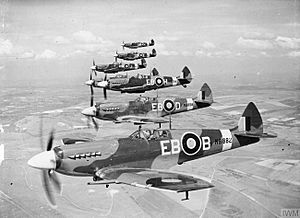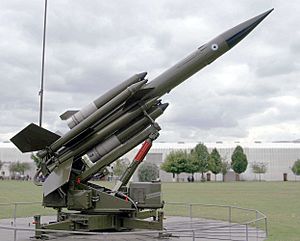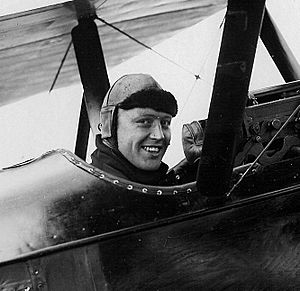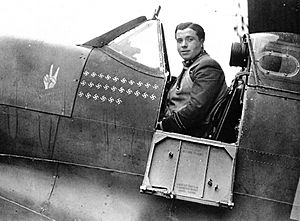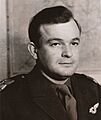No. 41 Squadron RAF facts for kids
Quick facts for kids No. 41 Squadron Royal Air Force |
|
|---|---|
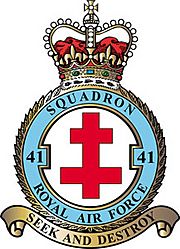
Squadron badge
|
|
| Active |
|
| Country | |
| Allegiance | King Charles III |
| Branch | |
| Type | Flying squadron |
| Role | Test and evaluation |
| Part of | Air Warfare Centre |
| Home station | RAF Coningsby |
| Motto(s) | Seek and Destroy |
| Anniversaries | April 2016 (centenary) |
| Aircraft | Eurofighter Typhoon FGR4 |
| Battle honours | * Honours marked with an asterisk are emblazoned on the squadron standard |
| Website | 41 Squadron RAF |
| Commanders | |
| Current commander |
Wing Commander Lee 'Flash' Gordon |
| Notable commanders |
|
| Insignia | |
| Squadron tail badge |  |
| Squadron badge heraldry | A red double-armed cross on white background, originating from the squadron's association with St Omer, France which was its first overseas base in 1916 during the First World War. The cross is part of the town's arms. Approved by King George VI in February 1937. |
| Post 1950 squadron roundel |  |
| Squadron codes | PN (Jan 1939 – Sep 1939) EB (Sep 1939 – Feb 1951) FA–FZ (Jaguars) EB-A – EB-Z (2010 – present) |
No. 41 Squadron Royal Air Force is a flying squadron of the Royal Air Force (RAF). It's currently known as the Test and Evaluation Squadron (TES) for the RAF's Typhoon jets. You can find them at RAF Coningsby in Lincolnshire, UK.
The squadron first started in April 1916 during First World War as part of the Royal Flying Corps (RFC). They flew on the Western Front, attacking ground targets and fighting enemy planes. After the war, the squadron was temporarily closed in 1919.
No. 41 Squadron was restarted as an RAF squadron in 1923. They stayed in the UK until 1935, when they were sent to Aden during the Abyssinian crisis.
During Second World War, the squadron flew Supermarine Spitfire fighter planes. They fought bravely over Dunkirk and during the famous Battle of Britain. From 1941 to 1944, they flew missions over German-controlled Europe. After the Normandy landings, they moved to mainland Europe. In 1944–1945, they helped the Allies advance into Germany and stayed there until mid-1946.
After the war, the squadron was closed and reformed several times. They flew many different jet aircraft for fighting, scouting, and intercepting enemy planes. In 2006, their role changed to testing new fast jets and weapons. Since 2010, they have been the main Test and Evaluation Squadron for the Royal Air Force.
Contents
History of No. 41 Squadron
First World War: 1916–1919
No. 41 Squadron of the Royal Flying Corps first formed in April 1916 at Fort Rowner, RAF Gosport. However, it was quickly disbanded in May 1916.
The squadron reformed on 14 July 1916. They used Vickers F.B.5 'Gun Bus' and Airco D.H.2 'Scout' planes. In September 1916, they switched to Royal Aircraft Factory F.E.8 aircraft. They flew these planes to France in October 1916.
The F.E.8 was not the best fighter plane, so No. 41 Squadron mostly used them for attacking targets on the ground. On 24 January 1917, they got their first victories. The squadron flew in the Battle of Arras and the Battle of Messines. In July 1917, they got DH 5 fighters, which were not great. Finally, in October 1917, they received S.E.5a fighters, which they used for the rest of the war.
The squadron fought well in the Battle of Cambrai in November 1917. They also helped during the German spring offensive in March 1918 and the Battle of Amiens in August 1918. The squadron claimed its last victory of the war just two days before the fighting stopped.
After the war, the squadron returned to the UK and was officially disbanded on 31 December 1919. During the war, 17 aces (pilots who shot down many enemy planes) served with No. 41 Squadron. Their pilots and ground crews earned many awards for their bravery.
Between the Wars: 1923–1939

The squadron reformed at RAF Northolt on 1 April 1923, flying Sopwith Snipe planes. In 1924, they started using Armstrong Whitworth Siskin III biplanes.
In July 1929, 41 Squadron planes escorted French aviation pioneer Louis Blériot back to Dover. This recreated his first flight across the English Channel 20 years earlier. In October 1930, squadron members were part of the Guard of Honour for the victims of the R101 airship disaster.
During the 1930s, the squadron took part in air shows, sports, and training exercises. In October 1935, they were sent to Aden Protectorate to help during the Abyssinian crisis. They returned to the UK in August 1936 and were based at RAF Catterick.
In April 1937, 41 Squadron received its official badge and motto, 'Seek and Destroy'. The badge shows a red double-armed cross, taken from the town of St. Omer in France. This was where the squadron was first stationed overseas in 1916.
On 30 December 1938, 41 Squadron became the third RAF squadron to receive the new Supermarine Spitfire plane. By early 1939, they had a full set of twenty Mark I Spitfires.
Second World War: 1939–1945
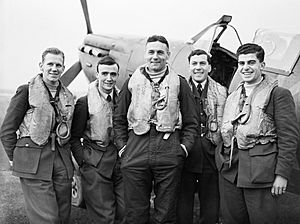
After war was declared in September 1939, 41 Squadron flew patrols in northern England. In May 1940, they moved south to RAF Hornchurch to help with the Dunkirk evacuation. They claimed six enemy aircraft destroyed.
After a short rest, the squadron returned south in July 1940 to join the Battle of Britain. They claimed 10 enemy aircraft destroyed in two weeks. On 5 September, the squadron had a very tough day, losing their Commanding Officer and several other pilots.
The Battle of Britain officially ended on 31 October 1940. Many pilots served with the squadron during this time, and they suffered many casualties. The squadron claimed over 100 victories from July to December 1940.
In February 1941, the squadron returned to Catterick for a break. Only a few pilots remained from those who fought in the Battle of Britain. New pilots joined from the British Commonwealth Air Training Programme.
In July 1941, the squadron moved to Merston, Sussex, to join the Tangmere Wing, led by Douglas Bader. They then flew many offensive missions over France.
On 12 February 1942, 41 Squadron attacked German warships trying to escape through the English Channel. They claimed three German planes destroyed. The squadron also supported the Canadian landings at Dieppe in August 1942. Their Commanding Officer, Sqn Ldr Geoffrey Hyde, was killed by anti-aircraft fire.
In February 1943, the squadron became one of the first to receive the new Griffon-engine Spitfire Mk.XII. They claimed their first victory with this new plane on 17 April. From June 1943, they often escorted large groups of bombers to targets in France, Belgium, and the Netherlands.
41 Squadron provided air support before and during the D-Day landings in June 1944. On D-Day, three pilots were hit by anti-aircraft fire. On 19 June, the squadron was moved to fight Germany's new V-1 flying bomb. By 28 August 1944, they had destroyed 53 V1s. Some pilots even used their wingtips to flip the V1s when they ran out of ammunition!
In September 1944, the squadron got Spitfire Mk.XIVs. They took part in operations against V2 rocket sites, supported Operation Market Garden at Arnhem, and fought in the Walcheren campaign.
The squadron moved to Belgium in December 1944. They attacked ground targets like vehicles and trains in Germany. Flying so low, they often faced heavy anti-aircraft fire.
In April 1945, the squadron moved into Germany. German resistance quickly fell apart. 41 Squadron claimed 33 enemy aircraft destroyed in the air and 21 damaged on the ground in the weeks before 3 May 1945. They had no pilots killed or wounded during this time.
After the war, the squadron was part of the Allied occupation forces in Germany. On 31 March 1946, 41 Squadron was disbanded by being re-numbered as 26 Squadron.
During the war, 41 Squadron claimed 200 enemy aircraft destroyed, 61 probably destroyed, 109 damaged, and 53 V-1 bombs destroyed. Their pilots earned many awards, including three DSOs and 21 DFCs. Sadly, 64 pilots were killed in action or died while serving.
Post War: 1946–2006
On 1 April 1946, just one day after being disbanded, 41 Squadron reformed in Scotland. They flew Supermarine Spitfire Mk. F.21s. In August 1947, they became No. 41 Instrument Flying Rating Squadron, using Airspeed Oxfords and North American Harvards.
In June 1948, the squadron returned to fighter defence, flying De Havilland Hornet jets. In January 1951, they fully entered the jet age with Gloster Meteor F.4 jets, later replaced by F.8s. Four years later, they received Hawker Hunter F.5s.
However, in January 1958, 41 Squadron was disbanded again as part of a plan to reduce the size of RAF Fighter Command. This made them the last fighter squadron ever based at Biggin Hill.
But, just like before, this was a quick change. On 16 January 1958, 141 Squadron was re-numbered as 41 Squadron. They took over 141's Gloster Javelin FAW.4 fighters and personnel.
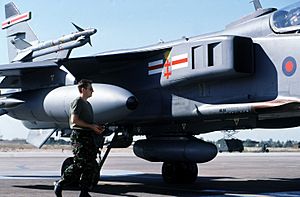
The squadron moved to RAF Wattisham in July 1958, where they got Javelin FAW.8s in January 1960. They were disbanded again on 31 December 1963.
On 1 September 1965, 41 Squadron reformed at RAF West Raynham, but this time as a missile defence squadron. They were armed with Bloodhound Mk.II surface-to-air missiles. This role lasted only five years, and the squadron disbanded again on 18 September 1970.
On 1 April 1972, the squadron was reborn at RAF Coningsby as a tactical fighter reconnaissance and ground attack unit. They used McDonnell Douglas F-4 Phantom FGR.2s. A special "Reconnaissance Intelligence Centre" (RIC) was formed to quickly develop and analyze photos taken by their planes.
In July 1976, "41 Designate Squadron" formed at RAF Coltishall to train with SEPECAT Jaguar GR1 aircraft. On 1 April 1977, the Coningsby squadron disbanded, and the Coltishall unit officially became the new 41 Squadron.
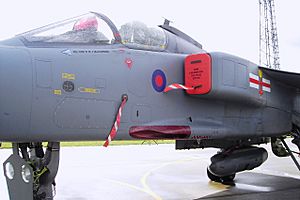
41 Squadron's role changed to low-level reconnaissance. They were involved in many conflicts in the 1990s and 2000s. In early 1991, during the First Gulf War (Operation Granby), they flew many reconnaissance and bombing missions against Iraqi forces with their Jaguars.
After the Gulf War, the squadron was sent to Turkey to help protect Iraq's Kurdish minority. Later, they flew policing duties over Bosnia from southern Italy. During this time, one of their Jaguars dropped the first RAF bomb over Europe since World War II, hitting a Bosnian Serb tank.
The squadron returned home in August 1995. They improved their photographic systems by introducing the Jaguar Replacement Reconnaissance Pod (JRRP) in August 2000. This new system used digital images instead of film, making analysis faster.
This digital system was used during the Second Gulf War (Operation Telic) in Iraq in March–April 2003. They were based in Turkey again, flying updated Jaguar GR3s.
In July 2004, it was announced that 41 Squadron would be disbanded again on 31 March 2006. This was part of a plan to reduce the size of the Defence Forces. The RAF planned to retire the Jaguar aircraft early and close RAF Coltishall.
However, just before the disbandment, 41 Squadron was given a new role. On 1 April 2006, they moved to Coningsby with 6 Squadron. They took on the role of the Fast Jet and Weapons Operational Evaluation Unit, or 'FJWOEU'.
Fast Jet & Weapons Operational Evaluation Unit: 2006–2010
The Fast Jet and Weapons Operational Evaluation Unit (FJWOEU) was formed on 1 April 2004. It combined several other units. On 1 April 2006, it took over 41(F) Squadron's number, saving 41 Squadron from being disbanded.
Their new aircraft were Panavia Tornados and Harrier GR9s. In 2006, the squadron celebrated its 90th anniversary. They continued to test many weapons and defence systems that were used by British forces around the world, including in Afghanistan.
Test and Evaluation Squadron: 2010 to Present
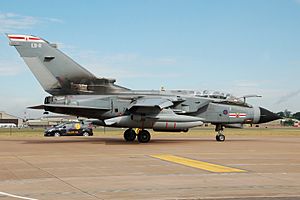
On 1 April 2010, the Fast Jet Test Squadron joined No. 41(Reserve) Squadron. This created the new 41 Squadron Test and Evaluation Squadron, or '41(R) TES', which is its role today.
In September 2010, the squadron celebrated the 70th anniversary of the Battle of Britain. They painted their current aircraft with World War II 'EB' codes. These codes honored different World War II pilots and their planes.
The squadron's Harrier jets were transferred to another squadron in November 2010. 41 Squadron then increased its fleet of Tornado GR4s. They flew only GR4s until April 2013.
On 29 April 2011, two of 41 Squadron's Tornado GR4s flew with two Typhoons over Buckingham Palace for the Royal Wedding of Prince William and Catherine Middleton.
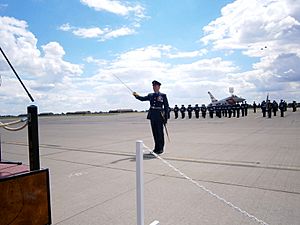
In 2012, for the London 2012 Olympic Games, 41 Squadron unveiled special tail markings on a Tornado GR4. This honored Gp Capt Donald O. Finlay, who commanded the squadron during the Battle of Britain. He had won Olympic medals in hurdles in 1932 and 1936.
A big change happened on 22 April 2013. 41 Squadron took over the Eurofighter Typhoon FGR4s from another squadron. This new role helps prepare for the introduction of the F-35B Lightning jet.
41 Squadron's World War II era 'EB' codes were painted on three of their new Typhoon aircraft. These honor important World War II pilots.

In July 2016, 41 Squadron celebrated its centenary (100th anniversary) with a parade and a special dinner at RAF Coningsby.
The squadron's Panavia Tornados were retired in late 2017. The last flight in this aircraft type was on 13 October 2017. 41 Squadron now only flies Eurofighter Typhoon FGR4s.
Notable People from 41 Squadron
Pilots Who Made a Difference
- Captain Valentine Baker (1916-1917): After leaving the RAF, he co-founded the Martin-Baker Aircraft Company. When he died in a test flight accident, his partner developed ejection seats. Martin-Baker ejection seats have saved almost 7,500 lives worldwide, including pilots who flew planes like the Jaguar, Harrier, Tornado, and Typhoon, which 41 Squadron has used.
- Lieutenant Eugene Barksdale (1918): This American pilot served briefly with 41 Squadron. He became a famous US test pilot, known for flying solely on instruments. A US Air Force base, Barksdale Air Force Base, is named after him.
- Squadron Leader Frederick R. G. McCall (1918): A Canadian ace who claimed 31 victories with 41 Squadron. After the war, he worked in civil aviation. Today, Calgary International Airport is named McCall Field in his honor.
- Air Vice-Marshal Raymond Collishaw (1923-1924): A Canadian pilot, he was the third-highest-scoring Allied pilot of World War I with 60 victories. He commanded 41 Squadron in peacetime.
- Air Commodore Patrick Huskinson (1930-1931): He commanded 41 Squadron and later became important in developing weapons during World War II, even after being blinded in an air raid. He helped develop large "bunker-busting" bombs.
- Air Commodore Allen H. Wheeler (1933-1936): He served as a Flight Commander and later became a consultant for the film industry, working on movies like The Blue Max.
- Squadron Leader George Bennions (1936-1940): He was the second most successful pilot on 41 Squadron during the Battle of Britain. He is famous for possibly damaging the plane of German ace Franz von Werra, who later became the only German POW to escape and return home during the war.
- Pilot Officer Eric Lock (1940): He became the most successful RAF pilot of the Battle of Britain, claiming 22 aircraft destroyed. He earned many awards for his bravery. He is still one of the RAF's top ten aces of World War II.
- Group Captain Donald O. Finlay (1940-1941): He was an Olympian before the war, winning bronze and silver medals in hurdles. He commanded 41 Squadron during the Battle of Britain. The squadron honored him during the 2012 London Olympics.
- Pilot Officer J. J. 'Chris' Le Roux (1940-1941): This South African pilot is credited with attacking and seriously injuring German General Erwin Rommel in his staff car in Normandy in 1944. This single action removed a key German commander from the battlefield.
- Flight Lieutenant Bram van der Stok (1941-1942): This Dutch pilot was shot down and captured. He was one of only three airmen who successfully escaped during "The Great Escape" and made it back to the UK. His story was part of the famous film The Great Escape.
- Sergeant Pilot George F. Beurling (1942): A Canadian pilot who served briefly with 41 Squadron, claiming his first two victories here. He became Canada's leading World War II ace, known for his amazing flying skills but also for being a bit rebellious.
- Prince Emanuel Vladimirovitch Galitzine (1943): A Russian prince whose family fled the October Revolution. He joined the RAF and served with 41 Squadron. He later worked in civil aviation and maintained ties with Russia.
- Flying Officer Peter Gibbs (1944-1945): After the war, he became a professional musician with the London Symphony Orchestra. He was known for standing up to famous conductor Herbert von Karajan. He also loved flying privately and tragically died in a mysterious plane crash in Scotland.
- Sergeant Pilot Aharon Remez (1945-1946): This Palestinian pilot served with 41 Squadron at the end of World War II. He helped holocaust survivors travel to the Middle East. In 1948, he became the founder and first Commanding Officer of the Israeli Air Force. He later served as the Israeli Ambassador to the UK.
- Squadron Leader Terry Spencer (1944-1945): He was a V1 "Doodlebug" ace, shooting down seven of the flying bombs. He was shot down twice and escaped from a POW camp by bicycle and motorcycle. He later became a successful freelance photographer for LIFE Magazine, covering conflicts and even touring with The Beatles.
Aircraft Used by 41 Squadron
| Aircraft Type | When Used |
|---|---|
| Airco de Havilland DH.2 ‘Scout’ | July 1916 |
| Vickers F.B.5 ‘Gun Bus’ | July 1916 |
| Royal Aircraft Factory F.E.8 | September 1916 |
| Airco de Havilland DH.5 | July 1917 |
| Royal Aircraft Factory S.E.5a | October 1917 |
| Sopwith 7F.1 Snipe | April 1923 |
| Armstrong Whitworth Siskin III/IIIa | April 1924 |
| Bristol Bulldog 105A Mk. IIa | October 1931 |
| Hawker Demon Mk. I | July 1934 |
| Hawker Fury Mk. II | October 1937 |
| Supermarine Spitfire Mk. I/Ia | December 1938 |
| Supermarine Spitfire Mk. IIa | October 1940 |
| Supermarine Spitfire Mk. Va & Vb | July 1941 |
| Supermarine Spitfire Mk. XII | February 1943 |
| Supermarine Spitfire Mk. XIV | September 1944 |
| Hawker Tempest Mk. V | September 1945 |
| Supermarine Spitfire Mk. F.21 | April 1946 |
| Airspeed Oxford AS.10 | August 1947 |
| North American Harvard | August 1947 |
| De Havilland Hornet F.1/F.3 | June 1948 |
| Gloster Meteor F.4/F.8 | January 1951 |
| Hawker Hunter F.5 | July 1955 |
| Gloster Javelin FAW.4/FAW.8 | February 1958 |
| Bloodhound Mk. II S.A.M. | September 1965 |
| McDonnell Douglas Phantom FGR.2 | April 1972 |
| SEPECAT Jaguar GR.1/GR.3/T4/GR.3a | July 1976 |
| Hawker Siddeley Harrier GR9 | April 2006 |
| Panavia Tornado F3 | April 2006 |
| Panavia Tornado GR4 | April 2006 |
| Eurofighter Typhoon FGR4 | April 2013 |
Images for kids
-
R101 disaster: 41 Squadron pilots and ground crew formed a part of the Guard of Honour for the 48 victims in the Palace of Westminster on 9 October 1930.
-
The interior of the doors on 41 Squadron's hangar at RAF Coltishall on the day the station was closed, 1 April 2006.
-
A flypast of a 41 Squadron Tornado and three 41 Squadron Harriers at RAF Coningsby, October 2006.
-
41 Squadron Eurofighter Typhoon FGR4 ZJ914 'EB-H' at the RAF Waddington Air Show in July 2013. This aircraft code honors Spitfire XIV, NH915, EB-H.


